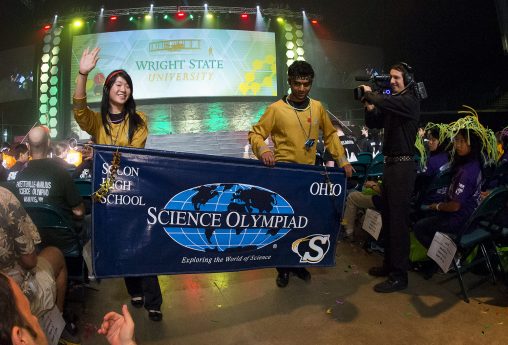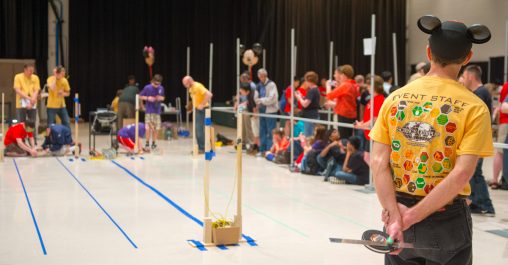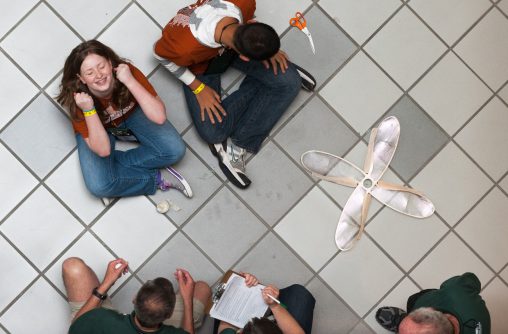
More than 5,000 students, educators and parents will descend on Wright State for the Science Olympiad National Tournament May 19–20.
Talented teens from across the nation as well as Japan are descending on Wright State University to battle it out in intensely competitive science and engineering projects — from Robot Arm and Hovercraft to Microbe Mission and Food Science.
The prestigious 2017 Science Olympiad National Tournament, which will be held May 19–20, is expected to attract more than 5,000 students, educators and parents from all 50 states. A Global Ambassador Team from Gifu High School in Japan will participate as guests in selected events, including Helicopters, Game On and Forensics.
For these bright young students, the national tournament is a launching pad. Many will go on to top universities, where they will feed their natural curiosity, advance their research skills and sharpen tools that will shape the future of science.
Wright State Provost Thomas Sudkamp said the university couldn’t be more thrilled to host the best and brightest middle and high school students.
“We have seen many of your great young minds at work during the invitational competitions held at Wright State University,” Sudkamp said. “Your ingenuity, innovation and sheer brilliance are beyond compare. It makes me feel very positive about the future of this country when I see such genius in the next generation.”
Winners of the Science Olympiad will be offered scholarships to Wright State. All official members of the first-place team in the middle school and high school divisions will receive a $2,500 scholarship, renewable for four years. In both divisions, the university will also award $1,000 scholarships to the first-place winners of each individual event, also renewable for four years. All awards are subject to admission requirements.
More information on the 2017 Science Olympiad National Tournament, including the competition schedule, is available at wright.edu/scienceolympiad.

Science Olympiad tests middle and high school students’ ability to solve physics, engineering, math, biology and anatomy problems in complex hands-on and lab events.
The school-based teams in the Science Olympiad program prepare and practice throughout the year, then compete in regional and state tournaments. The top 120 teams from state competitions across two divisions advance to the national tournament. Rigorous hands-on and lab events led by experts from government agencies, top universities and Science Olympiad state chapters cover topics in physics, epidemiology, astronomy, chemistry, meteorology and engineering.
“Students have been working for months to perfect their designs, build prototypes, practice lab skills and test their knowledge in topics spanning every letter in STEM,” said Jenny Kopach, Science Olympiad executive director. “We can’t wait to see which teams come out on top at the 2017 Science Olympiad Tournament.”
Ohio teams coming to the national tournament include Tower Heights Middle School in Centerville, Mentor High School and Solon middle and high schools.
Mount Vernon High School in Iowa broke a 25-year winning streak of Ames High School to win the Iowa Science Olympiad State Tournament and earn a bid to the national tournament. A home school team, Treasure Valley, took the middle- and high school divisions at the Idaho Science Olympiad.
Science Olympiad injects the university with an even more youthful electricity, with swarms of teens exploring the campus and chatting excitedly about their science projects. Conference rooms, atriums and classrooms become battlegrounds of battery buggy, egg drop and chemistry competitions.
And the Science Olympiad has an estimated $1.7 million economic impact in Greene County alone, with many of the participants staying in hotels, eating at restaurants and shopping, according to the Greene County Ohio Convention & Visitors Bureau. About 1,640 Olympiad students will stay in housing at Wright State, with the university providing more than 6,000 meals.
Keynote speaker for Science Olympiad will be Elliott R. Brown, endowed chair in experimental sensor physics at Wright State. Brown is an expert in terahertz radiation, which consists of invisible light waves in the electromagnetic spectrum higher in frequency than microwave and lower than infrared light.
On May 18 at 9 a.m., Wright State’s University Center for International Education (UCIE) has coordinated a visit for the Japanese team to the National Museum of the United States Air Force, the world’s largest military aviation museum and which features a dazzling collection of historic military aircraft, followed by a special campus tour for the 16-person Japanese delegation.
Wright State is no stranger to Science Olympiads. It has hosted numerous invitational and regional Science Olympiads, which draw students primarily from Ohio. And Wright State hosted the Science Olympiad National Tournament in 2013.

Conference rooms, atriums and classrooms become battlegrounds of battery buggy, egg drop and chemistry competitions.
In hosting the national event, Wright State joins previous hosts such as the University of Chicago, George Washington University, the University of Colorado, Indiana University and the University of Illinois.
The Local Presenting Sponsor of this year’s Science Olympiad is the Wright State University Foundation. Anthem Blue Cross and Blue Shield is the Local Hosting Sponsor. The Local Supporting Sponsors are Barnes and Noble and Chartwells.
Science Olympiad is supported nationally by Wright State University, ArcelorMittal, NASA’s Universe of Learning Astrophysics STEM Learning and Literacy Network, Combined Federal Campaign, DuPont and the DuPont Center for Collaborative Research and Education, DuPont Pioneer, Lockheed Martin, NBC Universal Foundation, Ward’s Science, ACE Hardware, Centers for Disease Control and Prevention, Discovery Education 3M Young Scientist Challenge, National Oceanic and Atmospheric Administration and the National Marine Sanctuary Foundation, Orkin, Texas Instruments, U.S. Army ROTC, VWR Foundation, Academy of Model Aeronautics, Investing in Communities, MAKE Magazine, Society for Neuroscience, Yale Young Global Scholars, American Association for the Advancement of Science, Digital Manufacturing and Design Innovation Institute, Hardware Science, Japan Science and Technology Agency, Maker Education Initiative, Million Women Mentors, Milwaukee School of Engineering and The Groundwater Foundation.
Science Olympiad is a national nonprofit organization whose mission is to improve the quality of science education, increase interest in science, attract more students to science careers, foster teamwork, emphasize the problem-solving aspects of science and develop a technologically literate workforce. It has produced a generation of alumni who fill the hallways of top universities and corporations around the globe.

 Bags, boards and bonding
Bags, boards and bonding  More than 1,000 students to graduate at Wright State’s fall commencement ceremonies
More than 1,000 students to graduate at Wright State’s fall commencement ceremonies  Wright State’s Take Flight Program helps students soar high
Wright State’s Take Flight Program helps students soar high  Wright State Police Department delivers major donation to Raider Food Pantry
Wright State Police Department delivers major donation to Raider Food Pantry  Wright State engineering and computer science students earn prestigious federal SMART Scholarships
Wright State engineering and computer science students earn prestigious federal SMART Scholarships 